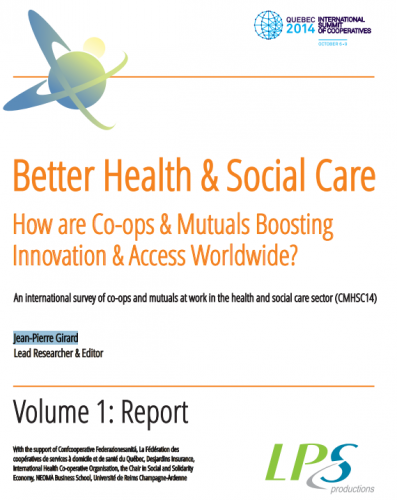An international survey of co-ops and mutuals at work in the health and social care sector
Why this research?
What is important about the engagement of cooperatives and mutuals in the health and social care sector? How do these organizations improve access to health care? How are they innovative?
How was the research carried out?
A global survey was conducted by an international research team from February to August 2014. It covered 59 countries from the five major regions of the world.
Download the summary
Download the report
Read the Canada Case Study from the report
Key figures from the research
- Total number of persons worldwide using the facilities of cooperatives and mutuals engaged in the health sector: 81,000,081.
- Total number of cooperatives and mutuals engaged in health activity: 4,961.
- Number of countries with cooperatives and mutuals which own and/or manage such facilities as clinics, medical centres, hospitals: 43.
- Number of social care cooperatives worldwide: 14,806.
- The cooperative model is applied in the pharmacy sector at all levels worldwide: retail pharmacies, wholesalers, drug producers (laboratories).
- In developing countries, health plans provided by cooperatives or mutuals frequently are the only affordable option for millions of people.
Innovation
- Health cooperative contractors provide high quality, efficient services for Costa Rica’s social security system.
- Continuum of care offerings by diverse types of cooperative in Italy.
- The Espriu Foundation network in Spain runs hospitals in collaboration with the government. This has led to cost savings for the national health system and to higher satisfaction among users.
- Cooperatives provide options for innovative Personal Health Record platforms in Finland.
- Mutuals provide health care to indigenous people in Paraguay.
- Women’s Health Cooperative has become a model of community empowerment due to its provision of easily accessible and affordable health care services in Tikathali village in Nepal.
- Thanks to a fruitful partnership with a Public Health Regional Centre and municipal housing office, a home care cooperative in Canada provides overall service to seven homes for the elderly and six homes for the disabled.
Major players
- UNIMED (Brazil) brings together 354 medical (doctor) cooperatives which represent up to 110,000 doctors and provide services to more than 19 million people.
- In Italy, 10,836 cooperatives operate in the social sector, mainly in social assistance and individual services.
- NOWEDA is a retail cooperative of pharmacies. It has 16 outlets in Germany and one in Luxembourg and has 8,600 pharmacies in membership. It is among Germany’s 150 largest enterprises.
- Close to 90% of Rwandans have a health plan with a Health Mutual Organization.
- ACHMEA (Netherlands) provides health and other insurance to about half of all Dutch households and is also active in seven other European countries as well as Australia.
Table of Contents:
Volume 1: Report
Acknowledgments
Foreword: Dr José Carlos Guisado
Executive Summary/Highlights
List of Abbreviations
Introduction
Operational Definitions
The Role of Co-ops & Mutuals in the Health & Social Care Sector: Overview
Co-ops & Mutuals in the Health & Social Care Sector: Global & Regional Data
Co-ops & Mutuals in the Health & Social Care Sector: Major Players & Innovation Table
Observations & Development Considerations
Next Steps
– Annex 1: Methodological Framework
– Annex 2: Basic Information related to Health Systems & their Funding Mechanisms
– Annex 3: Health Cooperatives Around the World – Background Studies
– Annex 4: Note on China & Health Co-ops
– Annex 5: Other Health Co-ops in the World
– Annex 6: Legal Considerations regarding Health Cooperatives & MHOs in Western & Central Africa
– Annex 7: The Project Team
Key References
Volume 2: National Cases





